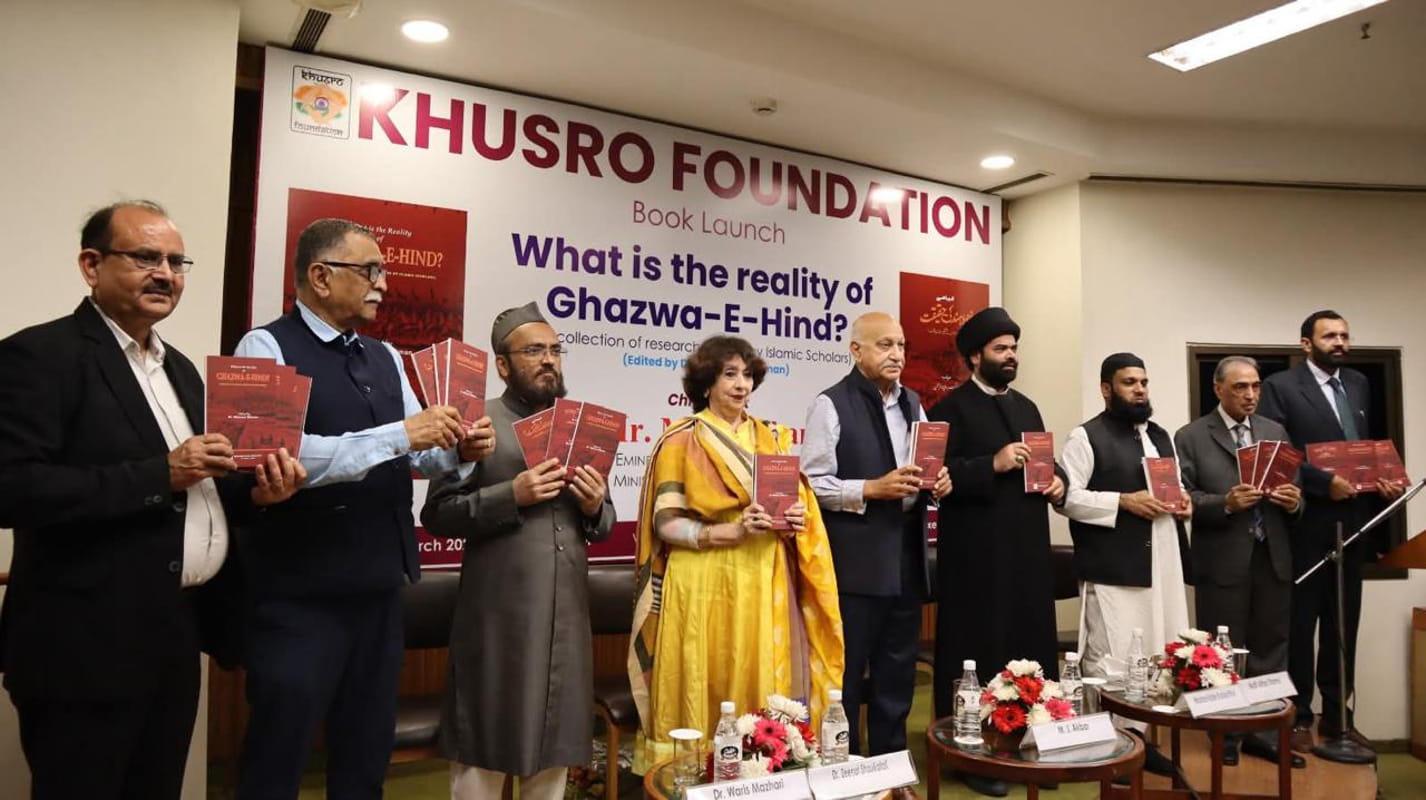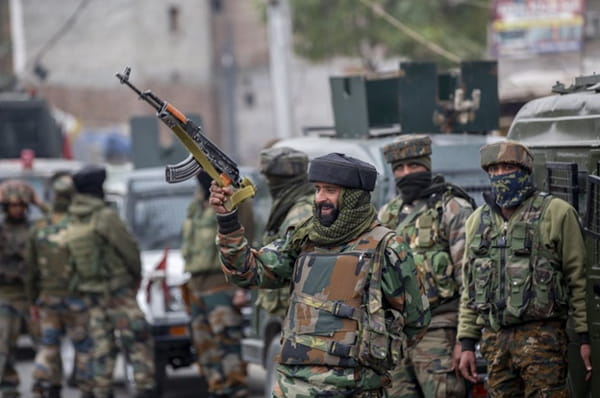
Launch of the book “What is the reality of Ghazwa-E-Hind” in Delhi, March 2024
The doctrine of Ghazwa-e-Hind, loosely translated as the “Battle for India”, has periodically resurfaced in South Asian discourse, often used by radical Islamist groups and occasionally cited by political actors to justify or counter narratives of religious confrontation. This article examines the historical origins, theological authenticity and political exploitation of the concept of Ghazwa-e-Hind.
Introduction
In September 2025, the Chief Minister of Uttar Pradesh, Yogi Adityanath, publicly warned that those “dreaming of Ghazwa-e-Hind will get a ticket to hell,” a statement made in the context of communal tensions in northern India.[1] This invocation of the term by a constitutional authority illustrates how a theologically questionable concept has captured the imagination to serve political and ideological ends in India’s socio-religious landscape.
The discourse surrounding Ghazwa-e-Hind is often characterised by promotion of myths, recourse to selective citation, and absence of academic scrutiny. Through a textual review of classical Islamic sources and recent political references, this article demonstrates that this doctrine is neither rooted in mainstream Islamic theology nor supported by authenticated Hadith literature. Instead, it is a modern political construct that feeds polarisation and militancy, particularly through propaganda networks based in Pakistan. The article concludes by suggesting intellectual, religious, and policy-based strategies to counter its misuse.
Defining Ghazwa-e-Hind
The Arabic word ghazwa (غزوة) denotes a military expedition personally led by the Prophet Muhammad (Peace Be Upon Him: PBUH), while sariyah refers to campaigns commanded by his companions in his absence. In this lexicon, Ghazwa-e-Hind would literally imply a prophetic expedition to the Indian subcontinent. However, no such event is recorded in authentic Islamic history or the canonical Hadith literature.[2]
Among the six recognised collections of Hadith (Sihah-Sitta), neither the Sahih Bukhari nor Sahih Muslim, the most authoritative compilations, mentions any narration about Ghazwa-e-Hind. It is only Sunan al-Nasa’i and Musnad Ahmad ibn Hanbal that refer obliquely to a conquest of India, but both narrations are widely classified as weak (da‘if) due to unreliable chains of transmission.[3] Even the Indian hadith scholar Shaikh Abdul Haq Muhaddis Dehlavi, and later reformers like Shah Waliullah and Shah Abdul Aziz, made no reference to such a prophecy in their extensive works on prophetic traditions.[4]
The absence of textual credibility in foundational Islamic literature establishes that Ghazwa-e-Hind lacks theological legitimacy.
Historical Background and Political Emergence
The doctrine’s revival is a modern phenomenon. It gained traction during the late 20th century, particularly after the break-up of Pakistan and the creation of Bangladesh in 1971.[5] Pakistani military and political elites began to deploy the term symbolically to frame conflicts with India within a religious context. During the Afghan–Soviet war, the idea was appropriated by militant networks such as Lashkar-e-Taiba and Jaish-e-Mohammed to inspire jihadist sentiment across the region.[6]
By the 1980s and 1990s, Ghazwa-e-Hind had evolved into a transnational slogan, invoked in Kashmir and propagated through madrasa literature, audio sermons, and later social media. Groups like Ansar Ghazwat-ul-Hind, an Al-Qaeda affiliate, explicitly embedded this concept into their operational ideology to frame the Kashmir insurgency as a divinely sanctioned campaign.[7] Thus, what began as a marginal theological curiosity became a potent instrument for political mobilisation and militant recruitment.
Theological and Logical Fallacies
The fundamental weakness of the Ghazwa-e-Hind doctrine lies in its contradiction with both the textual corpus and the ethical framework of Islam.
First, if ghazwa signifies an expedition led by the Prophet himself, the application of this term after his death is theologically impossible. Hence, the literalist reading of Ghazwa-e-Hind collapses under its own semantic burden.[8]
Second, the Qur’anic injunctions on warfare emphasise defensive struggle (jihad fi sabilillah) and prohibit aggression: “There is no compulsion in religion” (Qur’an 2:256). The militant extrapolation of a perpetual religious war against India violates this principle.
Third, the early Islamic conquests in the subcontinent, particularly those in Sindh under Muhammad bin Qasim, were driven by political and economic motives, rather than a doctrinal prophecy. None of the medieval Muslim empires, including the Umayyads, Abbasids, Ottomans, or Mughals, ever framed their Indian campaigns as fulfilment of a prophetic Ghazwa.[9]
The notion, therefore, is not only theologically baseless but also historically anachronistic.
Contemporary Promotion and Political Exploitation
The resurgence of Ghazwa-e-Hind owes as much to modern extremist propaganda as to political sensationalism. Militant organisations such as Lashkar-e-Taiba, Jaish-e-Mohammed, and Hizbul Mujahideen continue to invoke it as an eschatological mission aimed at establishing Islamic rule in India.[10]

Indian security forces in Kashmir, November 2020. | Associated Press..
These groups disseminate the idea through online recruitment platforms and encrypted communication networks, targeting impressionable youth. Indian law-enforcement agencies, including the Anti-Terrorism Squad (ATS) of Uttar Pradesh, have arrested individuals allegedly involved in promoting the doctrine digitally or conspiring under its banner.[11]
For instance, the UP ATS arrested a homoeopathy practitioner, Usama Maj Sheikh, from Maharashtra on suspicion of radicalising youth via an online network promoting Ghazwa-e-Hind.[12] Also, in a separate case, Tufail was arrested in Varanasi by UP ATS for allegedly distributing Ghazwa-e-Hind content over WhatsApp groups.[13]
In parallel, political actors in India occasionally revive the term to frame domestic law-and-order issues within a religious paradigm. The UP Chief Minister’s warning against Ghazwa-e-Hind “dreamers” is emblematic of a reactive political narrative that inadvertently legitimises a fringe term by placing it in mainstream discourse.[14] This dual propagation, from both extremist and political ends, reinforces polarisation and distracts from the theological falsity of the idea itself.
The Authentic Islamic Narrative
Islamic theology, when examined in its classical form, refutes the very foundations of Ghazwa-e-Hind. Authentic Hadith literature records no prophetic instruction to wage war on India, nor any special eschatological role assigned to the region. The Prophet’s message, as embodied in his farewell sermon, centred on equality, justice, and moral excellence, not territorial conquest.
Indian Islamic scholarship, spanning Deobandi, Barelvi, Ahl-e-Hadith, and Shia traditions, has consistently rejected militant interpretations of jihad. Organisations like Jamiat Ulema-e-Hind have repeatedly declared that Indian Muslims are bound by constitutional loyalty to the Indian state and must uphold peace and coexistence.
Furthermore, contemporary scholars such as Sheikh Imran Hussain of Malaysia and numerous South Asian theologians argue that the term ghazwa can metaphorically denote moral or intellectual struggle rather than military confrontation.[15] Hence, efforts to reinterpret Ghazwa-e-Hind within the lexicon of peace and spirituality are not only valid but necessary.
Counter-Narratives and Intellectual Response
The persistence of Ghazwa-e-Hind rhetoric demands multi-layered countermeasures at the theological, intellectual, and social levels.
1. Scholarly Intervention
Islamic scholars must continue to produce critical studies, books, and public statements denouncing the inauthenticity of this doctrine. Works such as What is the Reality of Ghazwa-e-Hind? published by the Khusro Foundation has already begun this process by offering linguistic, theological, and historical rebuttals.[16]
2. Media Literacy and Public Education
Mainstream media frequently amplify the term without context, turning it into a clickbait expression that fuels public paranoia. Journalists and commentators should be trained to seek expert opinion before referencing such doctrinal concepts.
3. Institutional and Societal Initiatives
Madrasas, universities, and interfaith platforms must develop curricula emphasising critical religious literacy and the ethics of pluralism. Public seminars, such as those organised by Khusro Foundation, help reclaim theological discourse from radical and populist distortion.
4. Legal and Security Framework
Law enforcement agencies should distinguish between theological discussions and militant propaganda. While curbing violent extremism is necessary, surveillance should be accompanied by transparent legal safeguards to prevent misuse against ordinary citizens.[17]
Conclusion
The Ghazwa-e-Hind doctrine is a historical fiction that has mutated into a political instrument. Neither the Prophet Muhammad (PBUH), his companions, or any recognised scholar of Islam, ever advanced such an idea. Its revival serves no religious purpose. Rather, it legitimises militancy and deepens communal fault lines.
To counter this distortion, India’s religious scholars, media institutions, and civil society must collaborate in dismantling the myth through evidence-based education and public engagement. The ultimate antidote to extremist ideology lies in intellectual clarity and ethical courage.
(Exclusive to NatStrat)
Endnotes